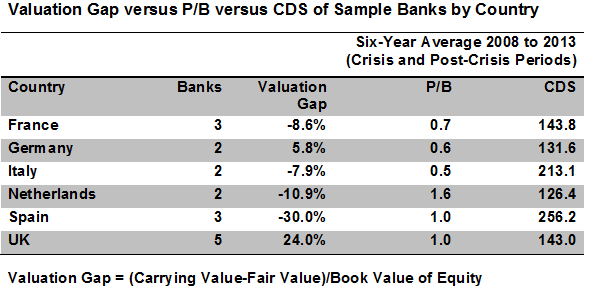Enhanced Disclosures Necessary for Investors to Compare Bank Balance Sheets across Countries
The second part of a CFA Institute study, Financial Crisis Insights on Bank Performance Reporting, reveals systematic differences in how banks disclose fair values of loans and write off bad or “impaired” debt across the European Union, the United States, Japan, Canada, and Australia. The results reflect a disparate range of impairment measurements that cannot only be explained by differences in prevailing economic conditions, and because loans are an important component of bank balance sheets and a key risk, the report recommends improving loan-related disclosures to enhance bank transparency.
The publication extends the analysis of the earlier issued report (part one), which assessed key factors influencing price-to-book ratios. Part two examines the relationship between disclosed loan fair values, impairments, and the risk profile of banks. The study also provides a breakdown of credit default swap (CDS) spreads which reflects bank-specific risks from a capital markets perspective. Our analysis, which covers the periods before, during, and after the height of the financial crisis (2003-2013), focuses primarily on large and complex banks in 16 countries.
Although there are many elements of bank financial reporting in which enhanced transparency is needed — including asset quality and risks associated with complex financial instruments such as derivatives and off-balance sheet arrangements (e.g., structured finance vehicles) — our study focuses on loans because they are a significant component of most banks’ balance sheets. What’s more, the accounting and accompanying disclosure in notes on these financial assets is a key part of the overall transparency of bank reporting. Loan impairments contain information on how well individual banks manage credit risk, which is at the core of the banking business model. Furthermore, as highlighted by the recently expanded audit reports of four main UK banks, loan write-downs are a key risk area for banks, and understandably so given the inherent subjectivity in how impairments are measured under current reporting requirements.
There are also many anecdotal claims about differences across countries and among banks in how loan impairments are measured, even under the same accounting standard (such as International Financial Reporting Standards, or IFRS). Indeed, a publication from the European Securities and Markets Authority (ESMA) reports the diverse practices across Europe concerning loan forbearance and recognizing loans as nonperforming assets. Our study helps to build a picture on the extent to which differences across countries exist and to heighten the importance of an effective asset quality review by the European Central Bank (ECB).
Key Findings
- Negative valuation gaps (where disclosed fair values in the notes are greater than the loan carrying value reported on the balance sheet) were prevalent amongst banks in France, Spain, Italy, Switzerland, and the Netherlands. This is in contrast to the positive valuation gaps observed among German and UK banks.
- A valuation gap ranging from -30% (six-year average) for Spanish banks to 24% for UK banks (see table below). This gap could not be readily explained on the basis of prevailing economic conditions during the financial crisis, or bank-specific risk as reflected in CDS spreads and price-to-book ratios.
- Loan impairment analysis across 16 countries, over time, contrasts in certain cases with a similar breakdown of CDS spreads, which in part reflects the credit risk of assets held. This suggests an inconsistent application of impairment accounting standards.

Three Recommendations to Enhance Bank Reporting
The study provides the following recommendations for accounting standard setters, regulators, and financial statement preparers to support more comprehensive and comparable bank reporting:
- Enhanced loan fair value disclosures: To help investors makes appropriate analytical adjustments. For example, explaining why disclosed fair values that are determined from internal models differ from the amounts reported on balance sheets.
- Enhanced Loan Impairments Disclosures: To enable investors to have a greater understanding of the sources of differences in the impairments reported on financial statements. We back this recommendation for expanded disclosures with findings from the 2013 CFA Institute Credit Loss Survey, which obtained CFA Institute member views on financial asset impairments and highlighted the need for disclosure enhancements in several key areas.
- Strengthened Regulatory Enforcement: To ensure consistency and comparability of reported financial statement line items and disclosed amounts.
To conclude, we note that the International Accounting Standards Board (IASB) recently issued its final financial instruments accounting standard, IFRS 9, and its expected credit loss impairment requirement should go some way towards addressing the problem of delayed write-downs. That said, our study highlights the other key challenge of comparing asset quality of banks across different countries due to the likelihood of inconsistent application of accounting requirements. Resolving this latter challenge will require a more active role by securities regulators in monitoring and encouraging consistent application of financial assets accounting and disclosure requirements. It also accentuates the importance of an effective asset quality review by the ECB and other national regulators to restore investor trust in what is presented on bank balance sheets.
If you liked this post, consider subscribing to Market Integrity Insights.


“There are also many anecdotal claims about differences across countries and among banks in how loan impairments are measured, even under the same accounting standard (such as International Financial Reporting Standards, or IFRS).”
You have big insight,Sir